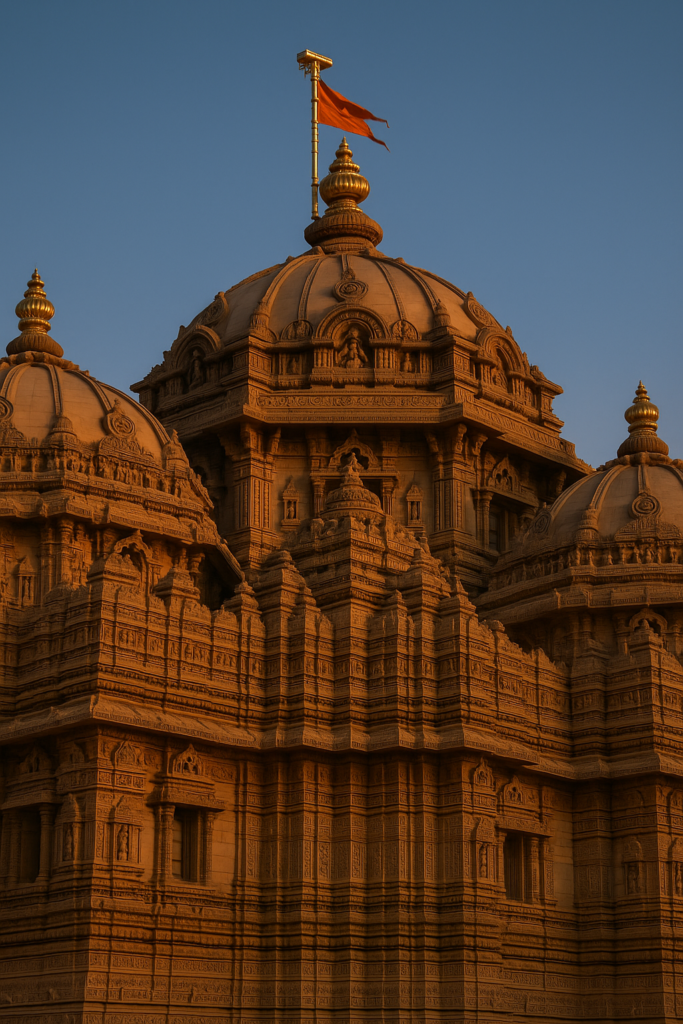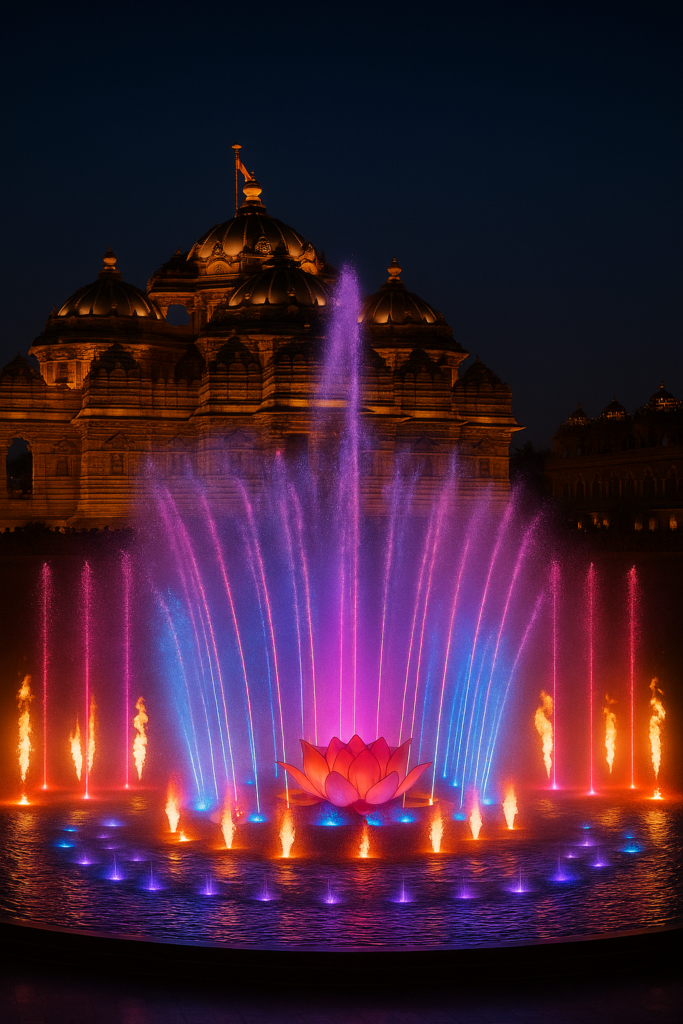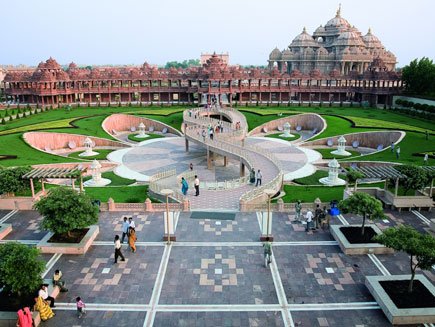A Timeless Temple in the Heart of Modern Delhi
Amidst the hum of traffic and city life in East Delhi, rises a spiritual sanctuary that feels untouched by time. The Swaminarayan Akshardham Temple isn’t just a temple—it is a living tribute to India’s eternal spiritual wisdom, handcrafted into stone and silence. Whether you approach it with faith or curiosity, what greets you is a sense of grandeur that doesn’t overwhelm, but invites. The temple welcomes more than 10,000 visitors every day—not just for darshan, but for a deeper experience of India’s soul.
“Where there is dharma, there is divinity. Where there is selfless service, there is Akshardham.”
What Does ‘Akshardham’ Mean?
The term Akshardham comes from two Sanskrit words—Akshar (eternal) and Dham (abode). It refers to the divine, imperishable home of God. In Swaminarayan philosophy, Akshardham is more than a celestial realm. It is the purest state of spiritual consciousness. The Delhi temple gives this idea a physical form—a space where divine ideals are carved into every surface, and where the journey is as sacred as the destination.
The Vision of Pramukh Swami Maharaj
The dream to build Akshardham Temple was envisioned by His Holiness Pramukh Swami Maharaj, the spiritual leader of BAPS Swaminarayan Sanstha. He didn’t want just another place of worship—he wanted to create a space where generations could connect with India’s ancient values in a way that was beautiful, accessible, and timeless. The result is not just architecture, but atmosphere—a space where even silence feels sacred.
Built by Hand, Anchored in Faith

Construction began in 2000 and was completed in just five years—an astonishing feat considering the temple’s scale and complexity. Over 8,000 artisans and volunteers, drawn from across India, worked together using ancient building techniques. No steel or concrete was used in the mandir. Instead, Rajasthani pink sandstone and Italian Carrara marble were shaped using traditional tools and chisels. Each stone is a testament to devotion, not just craftsmanship.
“Build the mandir not with stone, but with service. Build it not to last years, but to inspire souls.”
Inauguration of a Spiritual Landmark
Akshardham was inaugurated on 6 November 2005 in the presence of President A.P.J. Abdul Kalam and Prime Minister Atal Bihari Vajpayee. But beyond the political attendance, what mattered more was the sentiment the temple stirred. For many, it was the first time a modern religious space truly echoed the scale and purity of ancient Indian temples. It was a statement—India’s heritage is not past; it is present.
The Life and Legacy of Bhagwan Swaminarayan
At the heart of the temple is Bhagwan Swaminarayan himself. Born as Ghanshyam Pande in 1781, he left home at 11 and journeyed across India barefoot, absorbing spiritual practices and witnessing social injustice firsthand. Later, he settled in Gujarat and began teaching a spiritual philosophy rooted in truth, non-violence, and purity. His message was radical in its time: true devotion must be lived, not merely performed. Today, over 20 million followers worldwide carry his teachings forward.
“To see God in every being is the highest form of prayer.” – Bhagwan Swaminarayan
More Than a Temple—A Cultural Experience
Akshardham is not just for followers of the Swaminarayan tradition. It was designed as an inclusive spiritual campus where anyone—regardless of religion or nationality—can engage with India’s cultural and moral heritage. Through exhibitions, immersive experiences, musical fountains, and gardens, visitors connect with values like compassion, humility, service, and unity.
Built Near the Yamuna, Rooted in Vedic Tradition
Like many ancient temples, Akshardham was built near a sacred river—the Yamuna. Water bodies are considered spiritually purifying in Hindu thought, representing flow, life, and transformation. The temple’s east-facing orientation, vast mandir platform, and placement of domes and deities also follow principles of Vastu Shastra and Agama Shastra. But what sets it apart is the way these ancient rules are made relevant—accessible even to first-time visitors.
Harmony Between Spiritual Depth and Public Access
Akshardham’s location was chosen with intention. It is just a few steps away from the Akshardham Metro Station, making it reachable by all. It remains open to families, school children, tourists, and pilgrims alike. It does not expect ritual knowledge or devotion—but it offers an open hand to anyone seeking peace, clarity, or inspiration.
“Faith is not bound by rituals—it begins when the heart finds silence.”
Why Akshardham Still Matters Today
At a time when attention spans are short and spirituality is often rushed, Akshardham stands quietly as a counterpoint. It asks visitors to slow down. To reflect. To feel. Whether you spend five hours exploring its exhibitions or five minutes watching the sunset behind its sandstone towers, you leave with more than you came with.
The Architecture and Symbolism of Akshardham Temple
A Temple Carved from Devotion, Not Just Stone
What sets Akshardham apart is not just its scale, but the devotion that shaped every detail. The main Mandir stands as the centerpiece—towering and silent, yet speaking volumes through its carvings, domes, and proportions. Crafted from Rajasthani pink sandstone and Italian Carrara marble, its materials were consciously chosen: sandstone represents spiritual strength, while marble reflects purity and eternal peace.
Importantly, no iron or steel has been used in the construction—a tribute to Vedic principles of temple design, where natural elements are believed to better channel spiritual energy. The temple’s harmonious dimensions follow ancient Vastu Shastra and Pancharatra Shastra traditions, ensuring every angle is in tune with cosmic rhythm.
The Gajendra Peeth: Elephants as Vessels of Wisdom
As visitors approach the Mandir, they are greeted by the breathtaking Gajendra Peeth—a 1,070-foot-long plinth adorned with over 148 life-sized stone elephants, carved with astonishing realism and detail. But these are not mere decorative creatures.
Each elephant tells a story from Indian scriptures, folklore, and even real historical events. There are scenes of elephants in royal courts, in battlefields, at peace with sages, and dancing in joy. Through this, the Gajendra Peeth reminds us of the values elephants embody: wisdom, strength, loyalty, and harmony with nature.
Together, the carvings form a moving tapestry that links the animal world with the divine, celebrating the unity of all life.
Narayan Sarovar: Sacred Waters That Circle the Mandir
Surrounding the temple is the Narayan Sarovar, a serene body of water that pays tribute to India’s sacred rivers. It contains water from 151 holy rivers and lakes, including the Ganga, Yamuna, Narmada, Kaveri, and Godavari.
Pilgrims walk its edge, pausing at 108 sculpted Gaumukh (cow faces) that gently release the waters—a symbolic act of purification and connection with the sacred geography of India. Every step here is meditative, as the sound of trickling water merges with temple bells and distant chants.
Intricate Carvings and Symbolic Motifs
Across the temple, over 20,000 carved figures reflect a microcosm of Indian tradition: from divine avatars like Rama, Krishna, and Parvati, to sages like Vyasa and Shankaracharya, and celestial beings dancing in celebration. The motifs extend to floral vines, animals, birds, and abstract forms—each carefully selected to convey philosophical truths.
Unlike modern constructions driven by efficiency, Akshardham is the result of 10 million man-hours of hand craftsmanship. The carvings aren’t just art—they’re teaching tools, spiritual reminders, and emotional touchpoints.
As one moves through its stone corridors and pillared walkways, it’s easy to forget you’re in a structure completed just two decades ago. The temple breathes the spirit of ancient India—timeless, expansive, and profoundly alive.
The Spiritual Rhythm of Akshardham: Daily Rituals, Aartis, and Sacred Devotion

“Where silence speaks, and devotion echoes.”
Amid its grand architecture and cultural exhibits, Akshardham remains, first and foremost, a place of worship. The sacred atmosphere doesn’t stem from the stone carvings alone—it is sustained by the rituals, chants, and unwavering devotion that fill the temple from dawn to dusk.
Every day begins with Mangala Aarti, the morning ritual that awakens the deity with light and music. Priests chant ancient verses as the first rays of sunlight kiss the pink sandstone. Visitors who witness this aarti often describe it as a deeply personal moment—a communion between spirit and form, between worshipper and divine.
Later in the day, the Shangar Aarti follows—an offering of beauty, where the murtis are adorned in rich silks and floral garlands. These rituals are performed with heartfelt precision, preserving centuries-old Swaminarayan traditions, yet resonating with modern seekers through their emotional clarity and musical depth.
A Living Temple with Timeless Energy
Unlike tourist-heavy destinations that become passive photo ops, Akshardham never loses its sense of being ‘alive.’ It’s not unusual to find volunteers sweeping the marble floors silently, or young devotees preparing flower offerings in quiet reverence. Their presence isn’t orchestrated—it’s spiritual service, known as seva, performed as a sacred act.
Throughout the day, devotees sit in meditative silence within the Mandir or chant quietly under the stone arches. The scent of sandalwood and rose lingers in the air. Time, here, bends inward.
Every evening culminates in the Sandhya Aarti, where devotees gather again before the divine images, singing with a depth that often moves even non-believers. The sounds of temple bells, cymbals, and sacred mantras spill out across the courtyard and into the reflecting waters of Narayan Sarovar.
Celebrations That Transcend the Calendar
Festivals bring a powerful surge of collective devotion. During Diwali, Janmashtami, Ram Navami, and Swaminarayan Jayanti, the temple is transformed. Thousands of lamps shimmer on every ledge, the air is filled with the fragrance of incense and sweet offerings, and bhajans rise like a river of sound.
These festivals aren’t merely commemorations—they are spiritual reenactments, where each ritual, song, and story invites devotees to live the presence of the divine, not just remember it.
Volunteers spend weeks preparing intricate rangolis, food for prasadam, and flower decorations that can stretch over hundreds of meters. The entire complex becomes a mosaic of devotion in action, drawing families, elders, students, and international visitors into one shared moment of reverence.
A Home for Seva and Stillness
Akshardham runs not as an institution but as a spiritual family, rooted in humility and service. The thousands of volunteers who maintain the temple and guide visitors are often BAPS devotees who live the values of Swaminarayan philosophy—simplicity, purity, and devotion without ego.
It is this spirit that holds the temple together—not just its carved pillars or marble domes. Akshardham is not visited, it is experienced. And this experience is more than visual—it is felt in the heartbeats of those who serve, sing, pray, and believe.
The Cultural Tapestry of Akshardham: Exhibitions, Water Show, and Symbolic Gardens

“To see is to believe. To experience is to transform.”
Beyond the sanctum of the Mandir lies a carefully designed cultural landscape that seeks not only to inspire awe but to elevate consciousness. It’s here that Akshardham distinguishes itself—not merely as a religious destination, but as a powerful learning space for values, history, and spiritual heritage.
Sahajanand Darshan: The Hall of Values
The journey through Akshardham’s exhibitions begins with Sahajanand Darshan, an immersive audio-animatronic experience that brings to life the teachings of Bhagwan Swaminarayan. Set across several tableaux, this exhibition features mechanical puppetry, lighting effects, and voice narration in over 30 languages.
But this is not a museum of relics—it is a school of ethics.
Children laugh and watch wide-eyed as young Ghanshyam (Swaminarayan’s childhood form) teaches honesty through action. Families pause as scenes of compassion, humility, non-violence, and family harmony unfold with startling simplicity. Even in a world saturated with digital content, the messages land—because they are timeless.
Neelkanth Darshan: A Spiritual Odyssey in Giant Screen Format
Next comes the giant-screen film theatre, showcasing Neelkanth Yatra, a cinematic re-telling of the 11-year barefoot pilgrimage of the teenage yogi Neelkanth across the Himalayas and beyond. Filmed on location in over 100 Indian settings and performed by real monks and locals, this 45-minute epic isn’t simply visual storytelling—it is inner travel through outer wonder.
Audiences emerge not just impressed, but deeply moved. Many report feelings of quiet reflection, a rare experience in a digital age. What does it mean to leave everything and walk toward the unknown with only faith? This is the question the film leaves behind.
Sanskruti Vihar: A Boat Ride Through 10,000 Years of India
The Sanskruti Vihar boat ride is often described as Akshardham’s most unexpected feature. Visitors board small wooden-style boats that gently glide through a tunnel of time—from Vedic rishis and Takshashila classrooms to ancient scientific discoveries and medieval trade routes.
The journey is brief—only 12 minutes—but the impact is lifelong. India’s spiritual and scientific contributions are displayed with childlike clarity but adult-level detail. Aryabhata, Panini, Charaka, Kalidasa—they all emerge from history as living lights. This exhibit doesn’t just foster patriotism—it inspires dharma-based pride rooted in genuine achievement.
Sahaj Anand: The Multimedia Water-Light Show
When night falls, the cultural complex comes alive once more with the Sahaj Anand Water Show, held in the open-air amphitheater by the Yagnapurush Kund, India’s largest stepwell.
Unlike typical sound-and-light shows, Sahaj Anand tells a profound story—a young child seeking truth is tested by ego, illusion, fear, and desire, before realizing that divine joy lies in surrender, not in struggle. Using fireballs, fountains, lasers, underwater flames, and projection mapping, the story unfolds not just on stage, but in the water and sky around you.
The audience is often spellbound—not by technology alone, but by how deeply human the message is. It’s not just seen—it’s felt. A lesson on humility, devotion, and inner peace, delivered in a format that speaks across generations.
Gardens That Speak Without Words

Between exhibitions and rituals, the temple invites quiet walks through gardens rich with symbolism. The Yogihriday Kamal, a lotus-inspired plaza with quotes from world visionaries (from Swami Vivekananda to APJ Abdul Kalam), honors the unity of wisdom.
Then there’s Bharat Upvan, a lush garden adorned with bronze sculptures of saints, sages, freedom fighters, and great kings. It’s a landscape of gratitude—toward India’s past, its values, and the forces that shaped its soul.
Every stone and shrub seems curated to remind visitors: you are part of a civilization much larger than your lifetime.
Planning Your Visit to Akshardham: Timings, Entry, What to Carry, and How to Reach

“When the soul is ready to receive, the path opens in stillness and order.”
Visiting Akshardham is unlike visiting a typical tourist spot. It’s not a place to rush through, nor one where casual attitudes fit. It is an invitation to slow down, to shed distractions, and to absorb beauty with reverence. The experience is heightened when you arrive prepared—not just logistically, but spiritually.
Entry Hours and Best Time to Visit
The Swaminarayan Akshardham Temple is open Tuesday to Sunday, with Mondays being the weekly closure day. The general timings are:
- Temple Complex Entry: 9:30 AM – 6:30 PM
- Exhibitions Timing: 10:00 AM – 6:00 PM (Last entry around 5:00 PM)
- Water Show (Sahaj Anand): Held after sunset, usually around 7:00 PM to 7:30 PM
While you can visit any time during the day, the ideal window is between 3:30 PM and 7:30 PM—this allows time for darshan, a relaxed walk through exhibitions, and ending with the water show. Mornings are quieter, but evenings capture the spiritual grandeur best, especially with the temple illuminated in golden light.
Security, Entry Process, and What You Can’t Carry
Akshardham has one of the most stringent but courteous security checks in India. To preserve the sanctity and safety of the premises, several items are not allowed:
Not allowed inside:
- Mobile phones
- Cameras
- Bags (including small handbags and pouches)
- Laptops, USBs, tablets
- Food items
- Smoking or tobacco products
- Any form of recording device
Visitors are required to deposit all belongings in the cloakroom, which is secure, free, and efficient. Still, it’s best to travel light and carry only the essentials: wallet, ID, and any medication you may need.
Pro tip: Avoid wearing belts with metal buckles, and wear footwear that can be removed easily.
Dress Code and Expected Decorum
Akshardham is a place of active worship, not just sightseeing. Visitors are expected to wear modest and respectful attire. While there’s no strict dress code, shoulders and knees should ideally be covered.
Shoes must be removed before entering the Mandir area. This is a barefoot zone of prayer—walk slowly, breathe deeply, and observe silence in the central sanctum.
Ticket Prices for Exhibitions and Water Show
While entry to the Mandir and the gardens is completely free, tickets are required for exhibitions and the water show.
Indicative ticket prices (subject to change):
- Exhibitions Combo (3 shows):
Adults: ₹250 | Seniors: ₹200 | Children: ₹150 - Water Show:
Adults: ₹90 | Seniors: ₹90 | Children: ₹60
Children under 4 are typically allowed free entry.
Tickets can be purchased at the designated counters inside the temple complex. Online booking is currently not available—arrive early to avoid queues, especially on weekends or holidays.
How to Reach Akshardham Temple
The temple is located on NH 24 (Noida Link Road), near Pandav Nagar, in East Delhi. It’s well-connected by road and metro, but private vehicles are discouraged due to limited parking and long walk-ins.
By Metro:
- Take the Blue Line (Dwarka–Noida/Vaishali) and get off at Akshardham Metro Station.
- From there, it’s a short 5–7 minute walk to the main gate.
By Car or Cab:
- Limited parking is available, but entry to vehicles is restricted close to the gate.
- It’s better to get dropped off and walk in.
By Bus or Auto:
- Few buses pass directly by Akshardham; metro is the most reliable option.
- Autos and cycle rickshaws are available nearby but must drop you before the security zone.
Duration of Visit and Must-See Checklist
If you want to experience Akshardham in full—not rushing, but absorbing—set aside at least 4–5 hours.
A balanced itinerary looks like this:
- 3:30 PM – 4:15 PM: Arrive, cloakroom, Mandir Darshan
- 4:15 PM – 5:45 PM: Visit Exhibitions
- 5:45 PM – 6:15 PM: Explore gardens and lotus courtyard
- 6:30 PM – 7:00 PM: Light refreshments (outside premises)
- 7:00 PM – 7:45 PM: Water Show
Is Photography Allowed?
Photography is strictly prohibited inside the temple complex, including exhibitions and gardens. This isn’t to limit memory-making, but to encourage presence. The absence of phones creates a rare digital silence—and it changes the experience. You begin to notice carvings, listen more intently, feel more deeply.
For those wanting memories, there are official photo booths at the exit where professional pictures are printed or emailed to you.
Navigating Your Visit: What Every Devotee and Tourist Should Know
Whether you’re a spiritual seeker or a curious traveler, a visit to Akshardham is a sensory and soul-enriching journey. From security checks to dress codes and temple etiquette, every step is designed to preserve the sanctity of the space while delivering a seamless experience for lakhs of visitors every year.
Getting There:
Akshardham is easily accessible via Delhi Metro (Akshardham Metro Station on Blue Line), just a short walk from the temple entrance. Well-connected roads and app-based cabs make it convenient for those arriving from central Delhi or NCR.
Entry and Timings:
Open Tuesday to Sunday, the temple welcomes visitors from 9:30 AM to 6:30 PM. The water show begins after sunset (usually around 7:30 PM) and lasts approximately 24 minutes. Entry to the temple is free, but exhibitions and the water show are ticketed. Tickets are reasonably priced and can be purchased at counters within the complex.
Security Protocols:
Expect airport-style security. Mobile phones, cameras, bags, food items, and electronic gadgets are not allowed. Free cloakroom facilities are available, but it’s best to carry only essentials.
Tips for a Fulfilling Visit
- Arrive early, especially on weekends and holidays, to avoid long queues.
- Dress modestly — both men and women should cover shoulders and knees.
- Allocate 3–4 hours to fully explore the temple, exhibitions, gardens, and show.
- Carry government ID if you plan to use lockers or ticketed areas.
- Visit in the evening to experience both the grandeur of daylight architecture and the illuminated beauty of the water-light show.
“Visiting Akshardham is not just sightseeing, it’s a pilgrimage for the senses,” says Renu Bansal, a Delhi-based culture writer. “The stillness, the scents of marigolds, the chants — they linger with you.”
Cultural Etiquette and Respectful Conduct
As a sacred space, Akshardham requires visitors to maintain silence in the mandir area and avoid touching sculptures or carvings. Photography is strictly prohibited across the entire complex — not just the temple interiors. Signage in Hindi and English guides visitors, and volunteers are always ready to help with directions or explanations.
Respect the sanctity of rituals in progress and refrain from entering garbhagriha (sanctum) areas unless permitted. Avoid using your phone on temple premises, even if you’ve retrieved it after exiting.
Spiritual Reflections and Leave-No-Trace Values
Beyond its marble and sandstone glory, Akshardham emphasizes internal cleanliness — of thought, speech, and behavior. Quotes from Hindu scriptures are prominently displayed, like:
“Yatra naryastu pujyante, ramante tatra Devataah.”
Where women are honored, divinity blossoms there.
Akshardham inspires reverence not just through scale, but silence. Visitors often describe a sense of peace and clarity after their visit, which no photograph could ever capture.
Closing the Journey: More Than a Monument
Before exiting, many visitors linger in the Yogi Hraday Kamal garden — a lotus-shaped lawn engraved with quotes from philosophers and leaders like Swami Vivekananda and A.P.J. Abdul Kalam. It’s a perfect place to reflect on the day’s experience.
As the sky darkens and the temple dome glows gold against twilight, one truth becomes clear — Akshardham is not merely seen, it is felt. It is as much a journey inward as it is a marvel outward.
Frequently Asked Questions About Akshardham Temple Delhi
What is the best time to visit Akshardham Temple in Delhi?
The ideal time to visit is on weekdays during the early morning hours or just before sunset. This allows visitors to explore the temple in daylight and stay for the evening water-light show without dealing with large crowds. Winter months (October to March) offer the most pleasant weather for walking around the vast open areas of the complex.
How long does it take to explore Akshardham fully?
A complete visit typically takes three to four hours. This includes time to see the central mandir, explore the exhibitions, walk through the gardens, and attend the Sahaj Anand water-light show. Visitors who want to engage deeply with each area or reflect quietly may need more time.
Is there an entry fee to visit the temple?
Entry to the main temple and gardens is free. However, the exhibitions (Hall of Values, Giant Screen Theatre, and Cultural Boat Ride) and the evening water show are ticketed. Prices are reasonable, and discounts are available for children and senior citizens. Tickets are sold inside the complex after the security check.
What is not allowed inside Akshardham Temple?
Visitors cannot carry mobile phones, cameras, bags, food items, or electronic devices inside the temple complex. Lockers and cloakrooms are available for secure storage. Photography and videography are strictly prohibited anywhere inside the complex, including the outdoor spaces.
Are there any dress code requirements for visiting?
Yes, modest attire is expected. Both men and women should wear clothing that covers shoulders, upper arms, and knees. If needed, sarongs and shawls are available at the entrance. The dress code helps maintain the sanctity and spiritual ambiance of the site.
Is Akshardham Temple accessible by metro?
Yes, Akshardham is easily reachable via the Delhi Metro. The Akshardham Metro Station (Blue Line) is located just 5–7 minutes from the temple entrance. Well-paved walkways and signboards make the route easy to follow.
Is Akshardham Temple open every day?
The temple is closed every Monday. It remains open from Tuesday to Sunday. Timings are generally from 9:30 AM to 6:30 PM, though the last entry is usually around 6 PM. The water show starts after sunset and varies slightly depending on the season.
What is the evening water-light show at Akshardham?
Known as the Sahaj Anand show, it is a 24-minute multimedia spectacle that uses fountains, lasers, lights, music, and storytelling to narrate a tale from ancient Hindu scriptures. It’s presented in the Yagnapurush Kund amphitheatre and is a favorite among visitors of all ages.
Are guided tours available at Akshardham?
While formal guided tours are not offered, the exhibitions and displays are self-explanatory and include English and Hindi narrations. Volunteers stationed across the complex are happy to answer questions and provide cultural context when asked.
Can foreigners visit Akshardham Temple?
Absolutely. Akshardham welcomes people of all faiths and nationalities. Foreign tourists often find the exhibitions helpful in understanding Indian culture and Hindu values. English signage and voiceovers make the experience accessible for international visitors.
Is food available inside the temple complex?
Yes. The Premvati Food Court offers a wide range of satvik vegetarian meals and snacks at reasonable prices. It’s open to all visitors and is located near the exhibition exit area. Outside food is not permitted.
Is Akshardham suitable for children or senior citizens?
The temple is child-friendly and senior-friendly, with shaded walkways, rest areas, clean washrooms, and wheelchair facilities. Children particularly enjoy the boat ride and the light show, while senior citizens find peace in the spiritual atmosphere.

